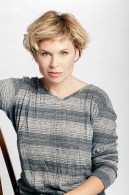
Sigalit Landau
Sigalit Landau, an Israeli sculptor, video, and installation artist, will present the Ruth Ellen Steinman and Edward J. Bloustein Memorial Lecture, “The East Bound Salt Route and the Crystal Islands” on Monday, September 10, 2012. The event will be held in the Special Events Forum at Rutgers University’s Edward J. Bloustein School of Planning and Public Policy, Civic Square Building, 33 Livingston Avenue, New Brunswick, NJ. It will begin at 5:00 p.m.
A corresponding exhibit of Landau’s work will beheld at the Princeton University Art Museum, August 18, 2012–January 13, 2013.
Landau’s work is that of a bridge-builder, fueled by politics and poetry. Consciously and unconsciously, she looks for new and vital materials to connect the past to the future; the west to the east; the private with the collective; the sub-existential to the Uber-profound; the found objects to the deepest epic narratives and mythologies.
In her lecture Landau will trace movements, modes of action, and pulses of reaction by focusing on her creations from the last 10 years. She will also discuss future projects.
Landau’s discussion will pivot around her creations, exploring the past, present, and future at the location of the Dead Sea, which features prominently in her work—its unique geology, the diverse histories of the surrounding countries, and the ongoing geo-political agony of its intersecting borders. Her work will be presented on-screen in a series of imagery and videos.
Her newest project, The Salt Route, is a planned bridge structure and trail linking the Israeli and Jordanian shores of the Dead Sea. The project’s goal is to create a bridge that makes a genuine connection between Israel and Jordan—two countries that for the past several years have been walking the fine line between cold and warm relations—while helping in saving the unique Sea and encouraging civic activism.
The event is free and open to the public. It is co-sponsored with the Rutgers Institute for Women and Art’s project, “The Fertile Crescent: Gender, Art, and Society,” which seeks to focus on illustrating the heterogeneity of countries, cultures, and individualities of women artists in the Middle East and its Diaspora.
The Fertile Crescent: Gender, Art, and Society has been made possible through support from the National Endowment for the Arts; the Andy Warhol Foundation for the Visual Arts; the Violet Jabara Charitable Trust; the Artis Foundation, which helped fund the participation of the five Israeli artists in the exhibition, Ofri Cnaani, Ayana Friedman, Efrat Kedem, Sigalit Landau, and Ariane Littman; and the Harris Finch Foundation. Several programs were made possible by a grant from the New Jersey Council for the Humanities, a state partner of the National Endowment for the Humanities. In addition, Fertile Crescent partner institutions provided both financial and in-kind contributions, as did Basem and Muna Hishmeh, along with other individuals. The Rutgers University Institute for Women and Art is a unit of the Rutgers Office of the Associate Vice President for Academic and Public Partnerships in the Arts and Humanities and a member institute of the Rutgers Institute for Women’s Leadership. The IWA receives General Program Support from the New Jersey State Council on the Arts.
The Ruth Ellen Steinman and Edward J. Bloustein Memorial Lecture was established to honor the memory of these two extraordinary individuals. For nearly 19 years, the Blousteins dedicated their enormous energies to Rutgers, The State University of New Jersey. The fund was created in 1988 after Ruth Ellen died following a long and heroic battle with illness. Sadly, there was cause to broaden the purpose of the fund a year later when Edward Bloustein, Rutgers’ beloved president, died suddenly in December 1989. The endowment supports an annual lecture series that is intended to celebrate the values and interests Ruth Ellen and Ed cherished and cultivated throughout their lives, namely the preservation of animal species and the natural environment; the celebration of love, happiness, and laughter as tools of clinical medicine; and the exploration and promotion of humane values.
